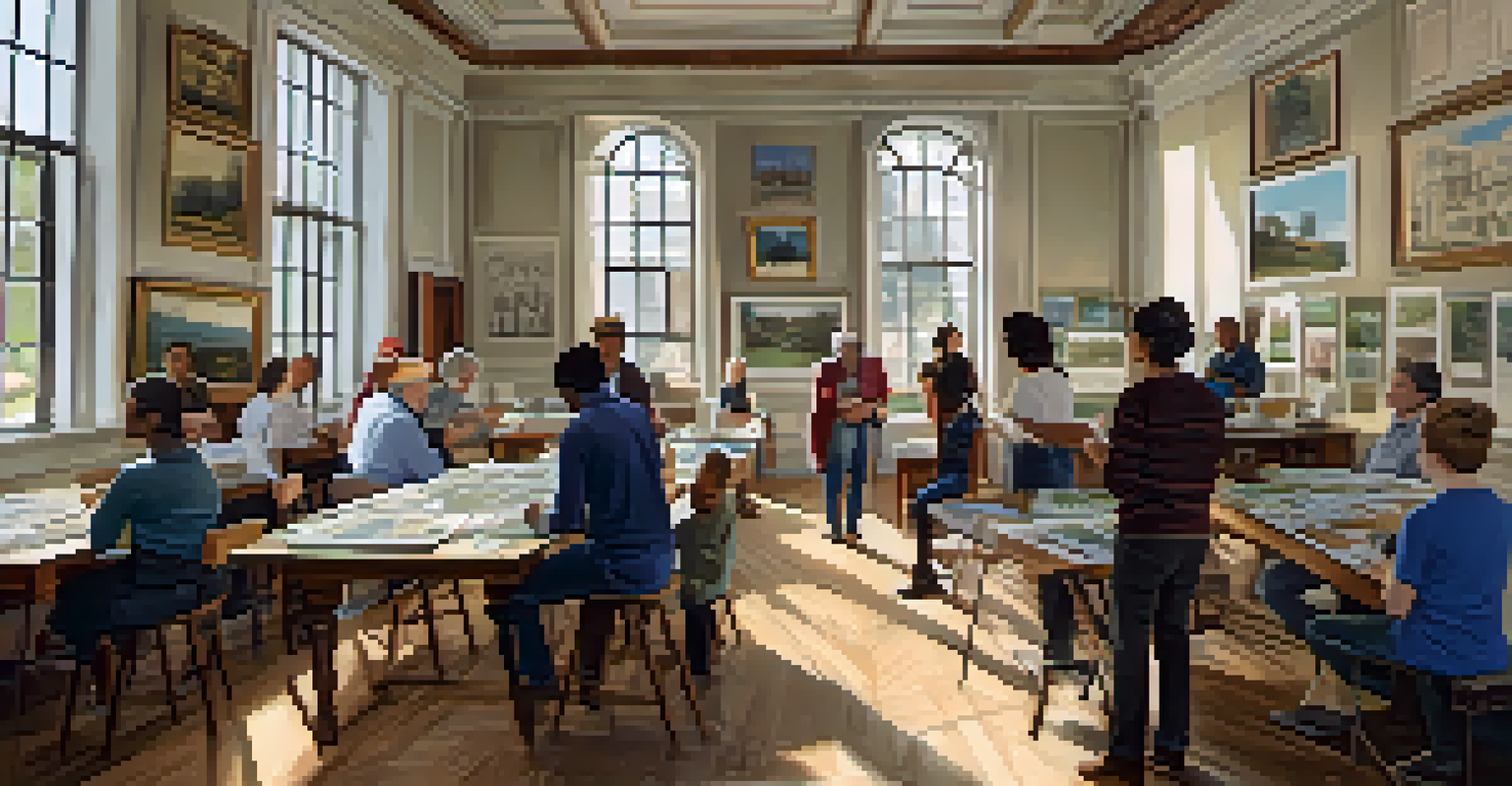The Role of Local Government in Historic Preservation Efforts

Understanding Historic Preservation and Its Importance
Historic preservation refers to the efforts to protect and maintain buildings, sites, and neighborhoods that hold historical significance. It plays a crucial role in preserving the cultural heritage of a community, allowing future generations to connect with their past. By safeguarding these landmarks, we not only honor their history but also enhance the character of our towns and cities.
Preservation is not just about saving buildings; it’s about saving the stories they tell.
Local governments are at the forefront of these preservation efforts, guiding policies that protect historical sites. They work to ensure that development does not erase the unique stories that these places tell. This commitment to preservation fosters a sense of identity and belonging among residents, making communities more vibrant and appealing.
Additionally, preserved historic sites can become focal points for tourism, drawing visitors eager to explore the rich history. Local governments often recognize that investing in historic preservation can lead to economic growth, providing jobs and supporting local businesses. This multifaceted approach showcases how important local government is in maintaining our shared heritage.
The Role of Local Governments in Policy Development
Local governments are responsible for creating policies that promote the preservation of historic sites. They establish zoning laws and regulations that protect these areas from unsympathetic development. By crafting detailed plans and guidelines, they ensure that any changes made to these sites respect their historical significance.

In many cases, local governments also create historic districts, which are designated areas where preservation regulations apply. These districts help to maintain the architectural integrity of neighborhoods and prevent the demolition of important structures. Through public meetings and community input, local governments can gauge the needs and desires of residents, tailoring their policies accordingly.
Importance of Historic Preservation
Historic preservation is essential for maintaining community identity and cultural heritage for future generations.
Moreover, these policies often provide financial incentives, such as grants or tax credits, to encourage property owners to invest in the preservation of their historic properties. This collaborative effort not only supports individual homeowners but also strengthens the overall community by highlighting its unique history.
Community Involvement in Preservation Efforts
Community involvement is essential in historic preservation, and local governments often facilitate this engagement. They organize public workshops, forums, and events to educate residents about the importance of preserving local history. Such initiatives empower citizens to take an active role in the decision-making processes that affect their neighborhoods.
History is not a burden on the memory but an illumination of the soul.
Local governments can also encourage the formation of preservation societies or committees composed of community members who share a passion for historic sites. These groups can advocate for preservation initiatives, collaborate on restoration projects, and serve as a bridge between the public and government agencies. This grassroots involvement fosters a sense of ownership and pride in local history.
When communities rally around preservation efforts, the results can be profound. Not only do they help protect valuable historic assets, but they also strengthen community bonds and enhance local identity. This spirit of collaboration reinforces the notion that everyone has a stake in preserving the past for future generations.
Funding and Resources for Preservation Projects
Local governments play a pivotal role in securing funding for historic preservation projects. They often collaborate with state and federal agencies to access grants specifically designated for preservation efforts. By leveraging these financial resources, local governments can initiate projects that might otherwise be unfeasible due to budget constraints.
Additionally, local governments can provide technical assistance to property owners and community groups seeking to preserve historic sites. This support may include guidance on restoration techniques, architectural review processes, and navigating regulatory requirements. By offering these resources, local governments simplify the preservation process for those who may be unfamiliar with it.
Role of Local Governments
Local governments play a crucial role in creating policies and providing resources to support historic preservation efforts.
Moreover, local governments can promote public-private partnerships that further enhance funding opportunities. By working with nonprofit organizations, businesses, and other stakeholders, they can pool resources to undertake larger preservation initiatives. This collaborative approach not only maximizes financial support but also fosters a shared commitment to preserving local history.
Education and Awareness Initiatives
Education is a vital component of historic preservation, and local governments often take the lead in raising awareness. They conduct workshops, lectures, and walking tours to help residents understand the value of their historical sites. This educational outreach fosters a sense of appreciation and encourages community members to become advocates for preservation.
Local governments may also develop educational materials, such as brochures and online resources, detailing the history of significant sites and the importance of their preservation. By making this information accessible, they empower residents to take pride in their heritage. An informed community is more likely to support preservation efforts and participate in initiatives.
Furthermore, schools and local governments can collaborate to integrate local history into educational curricula. By teaching students about their community's past, they instill a sense of responsibility for its future. This generational approach ensures that respect for historic preservation is passed down, creating a culture of appreciation for heritage.
Challenges Local Governments Face in Preservation
Despite their crucial role, local governments face numerous challenges in historic preservation. Limited budgets can hinder their ability to allocate funds for preservation projects, especially in communities with pressing social or economic issues. As priorities shift, preservation efforts may struggle to secure the attention and resources they deserve.
Additionally, local governments often encounter resistance from developers and property owners who may prioritize economic growth over historic preservation. Balancing development and preservation can be a delicate dance, and local governments must navigate these tensions while advocating for the community's historical assets. This requires strong leadership and a clear vision for the future.
Community Engagement Matters
Active community involvement in preservation initiatives fosters a sense of ownership and strengthens local identity.
Moreover, public awareness and support can fluctuate, making it challenging for local governments to maintain momentum in their preservation efforts. To address these challenges, they must continuously engage the community, build relationships, and demonstrate the long-term benefits of preserving their history. It's a collective effort that requires commitment from all stakeholders.
Success Stories of Local Preservation Efforts
Throughout the country, there are numerous success stories of local governments successfully preserving historic sites. For instance, many cities have revitalized downtown areas by restoring historic buildings and attracting businesses. These efforts not only preserve the architectural heritage but also create vibrant spaces for community engagement.
One notable example is the preservation of the historic Main Street in several towns, where local governments have worked to revitalize these areas while maintaining their historical charm. By investing in facade improvements and public spaces, they have created inviting environments that draw both locals and tourists alike. This approach demonstrates how preservation can lead to economic revitalization.

Moreover, local governments often celebrate their preservation successes through events and recognitions, highlighting the importance of maintaining their heritage. These celebrations not only honor the past but also inspire other communities to follow suit. By sharing these success stories, local governments can motivate a collective effort to preserve history for future generations.